Cicadas in Texas are a fascinating and unmistakable part of the state’s summer landscape. With their buzzing songs echoing through trees and their sudden appearances after years underground, these insects are both mysterious and iconic. Texas is home to a diverse range of cicada species, including both annual and periodical types, each with unique traits and calls.
From the thunderous buzz of the Southern Giant Cicada to the synchronized emergence of the 13- and 17-year Magicicada species, cicadas in Texas showcase an impressive variety of sizes, colors, and behaviors. Their presence can be heard across forests, grasslands, and even urban neighborhoods, adding a natural soundtrack to hot summer days.
In this guide, we’ll explore 16 common cicadas in Texas with detailed pictures and identification tips. Whether you’re a curious observer or a passionate naturalist, learning about these insects will deepen your appreciation for one of the state’s most intriguing natural phenomena.
Common Cicadas Found in Texas
Magicicada septendecim (17-year cicada)
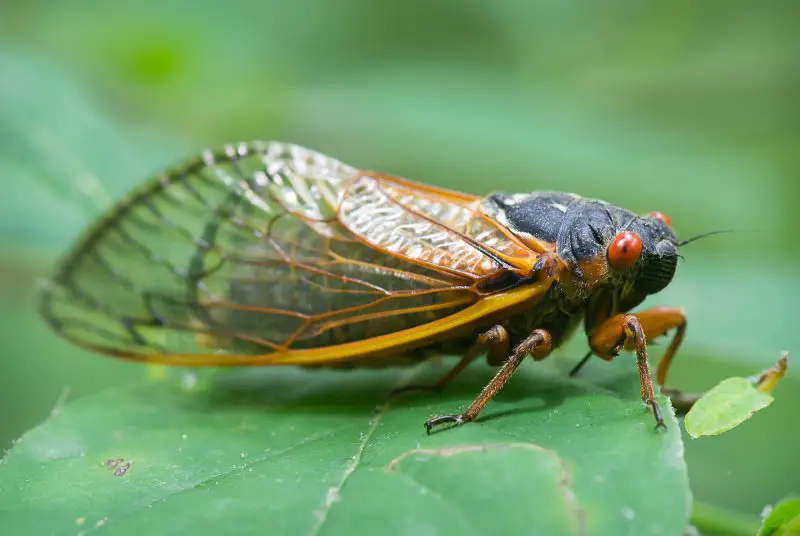
Magicicada septendecim is one of the most famous periodical cicadas known for its remarkable 17-year life cycle. This species spends most of its life underground as a nymph before emerging synchronously in large numbers. Adults have striking black bodies with orange wing veins and red eyes, making them easy to identify during their emergence.
These cicadas typically measure about 30 millimeters (1.2 inches) in length. Their large size and bright red eyes distinguish them from other cicada species. The wings are translucent with prominent orange veins, giving them a delicate but colorful appearance in flight or perched on tree bark.
The characteristic sound of Magicicada septendecim is a loud, rhythmic buzzing call that males produce to attract females. Their song is often described as a high-pitched, pulsing drone that can last for minutes, creating a distinct chorus during the peak emergence years. This call is vital for mating communication.
In Texas, Magicicada septendecim appears in mass every 17 years, typically during late spring and early summer. Their emergence is highly anticipated because of the dramatic rise in cicada noise and activity. These cicadas are mostly active during daytime and tend to congregate on hardwood trees, making them a seasonal spectacle for nature observers.
Magicicada cassinii (Cassini periodical cicada)
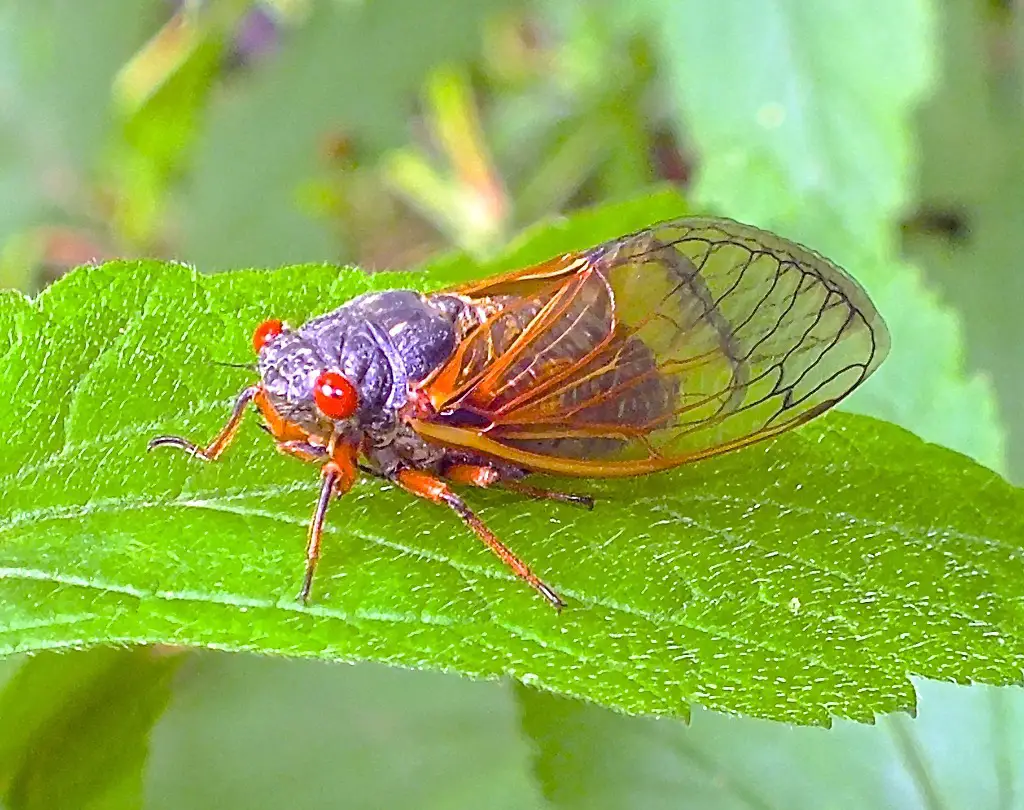
Magicicada cassinii is another 17-year cicada species found in Texas, notable for its synchronized emergence with other Magicicada species. This cicada displays black bodies with orange markings and red eyes, but generally has a more robust and stocky build compared to some of its relatives.
The typical size of Cassini cicadas ranges from 25 to 28 millimeters (about 1 inch) long. Their wings have prominent orange veins, and their bodies show a mix of black and orange coloration, which helps differentiate them from other Magicicada species. The red eyes are a signature trait shared among periodical cicadas.
Male Cassini cicadas produce a unique call distinct from other species. Their sound is a rapid, clicking or ticking noise that forms a buzzing chorus when many males call together. This distinctive song is used to attract females during the emergence period and is often heard echoing through Texas woodlands.
Magicicada cassinii emerges every 17 years during late spring to early summer, often overlapping with other periodical cicada species. In Texas, they usually appear in forested or suburban areas with mature hardwood trees. The cicadas are most active during warm daylight hours and spend little time on the ground.
Magicicada septendecula
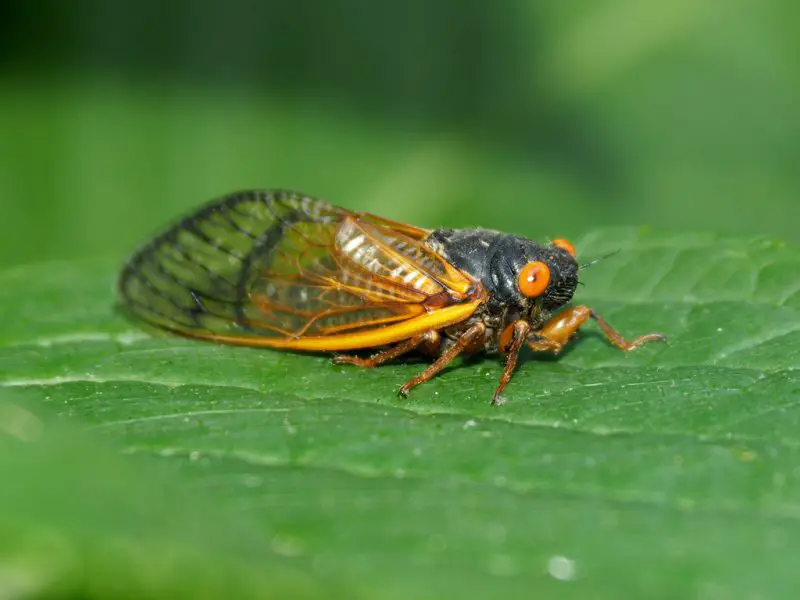
Magicicada septendecula is a 17-year periodical cicada with more subtle coloration compared to other species in the Magicicada genus. It has a mostly black body with less pronounced orange markings and the typical red eyes that make it identifiable during emergence. This species is less abundant but still part of the synchronous cicada broods.
The size of Magicicada septendecula generally falls around 25 to 30 millimeters (1 to 1.2 inches). Its wings are clear with orange veins, although the wing venation is slightly less vivid than in some related species. The cicada’s body appears darker, blending well with tree bark during daytime.
The males produce a distinct call that sounds like a high-pitched buzz or drone, though it is often softer and less complex than other Magicicada species. This sound helps males attract mates during the brief adult stage. The chorus of septendecula cicadas is noticeable but usually less intense than the calls of cassinii or septendecim.
In Texas, Magicicada septendecula emerges every 17 years, often alongside other periodical cicadas. Their appearance is primarily in wooded areas with mature deciduous trees. Adults typically appear in late spring and are active mainly during daylight hours before returning underground after mating and egg-laying.
Magicicada tredecim (13-year cicada)
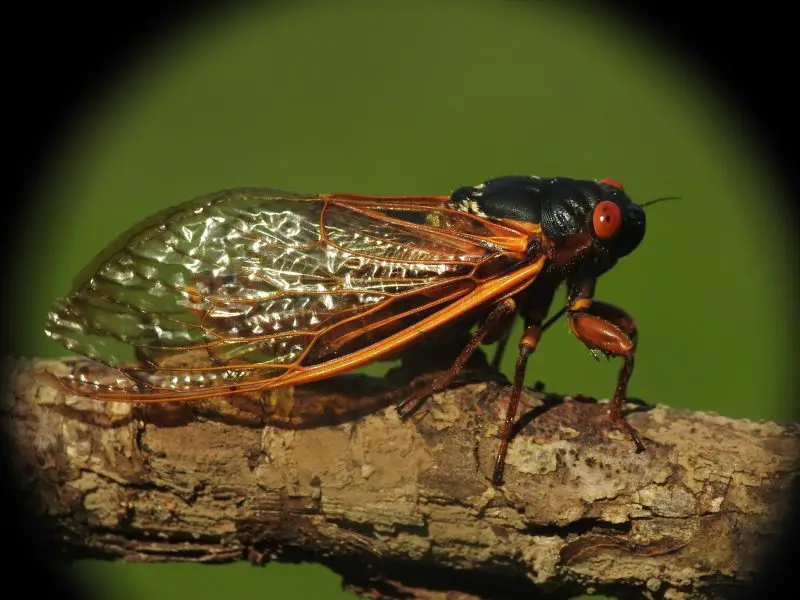
Magicicada tredecim is a periodical cicada species with a 13-year life cycle, differing from the more common 17-year species. It shares many physical traits with other Magicicada but can be identified by subtle differences in size and coloration. The body is black with orange stripes on the abdomen and red eyes, characteristic of periodical cicadas.
The size of tredecim cicadas is about 25 to 28 millimeters (1 to 1.1 inches) long. Their wings are translucent with prominent orange veins, which contrast against their darker bodies. The orange abdominal markings are more visible on this species than on some others, aiding in identification.
The song of Magicicada tredecim males is a distinct, pulsating buzz that is higher pitched and somewhat quicker than the 17-year cicadas. This acoustic signal is used for mating calls during their brief emergence period. The chorus of tredecim cicadas can be heard in forested areas where they emerge.
In Texas, Magicicada tredecim appears every 13 years, usually during late spring. Their emergence is less synchronized than the 17-year species but still occurs in large enough numbers to create noticeable sound and visual displays. These cicadas prefer hardwood trees and are active primarily during daylight.
Magicicada tredecassini
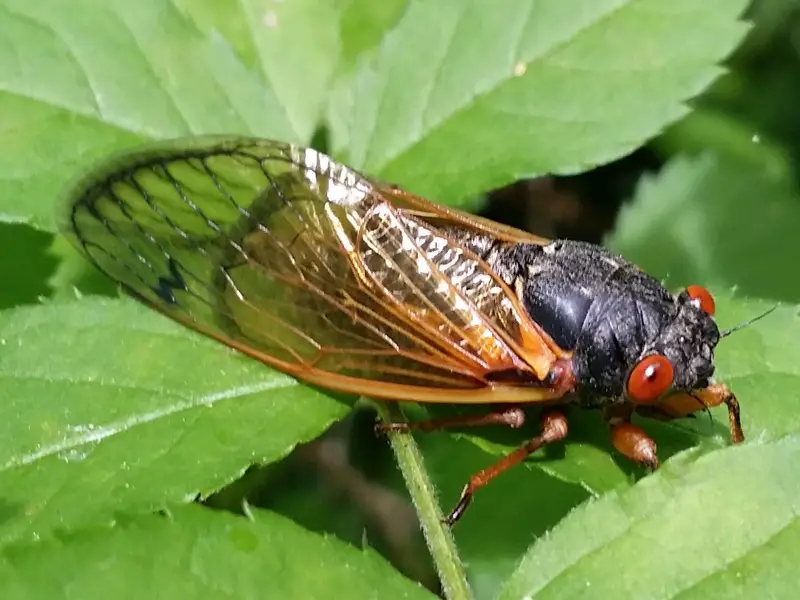
Magicicada tredecassini is a 13-year cicada closely related to the 17-year Magicicada cassinii but with a shorter life cycle. It exhibits a black body with orange highlights and red eyes, making it visually similar to cassinii but typically smaller and appearing more frequently due to its 13-year cycle.
The size of tredecassini cicadas usually ranges from 23 to 27 millimeters (about 0.9 to 1.1 inches). Their wings are clear with noticeable orange veins. The coloration on their body is similar to cassinii but often more muted. Red eyes remain a key identifying feature.
Male tredecassini cicadas produce a fast clicking or ticking call similar to the 17-year cassinii but slightly higher in pitch and shorter in duration. This sound forms part of the mating chorus during their emergence. The calls echo through Texas woodlands, signaling the presence of this species.
In Texas, Magicicada tredecassini emerges every 13 years, usually in late spring or early summer. They are found mostly in wooded habitats with mature trees, often overlapping in range with other periodical cicadas. Their adult stage is brief, focusing on mating and egg-laying before they die off.
Magicicada tredecula
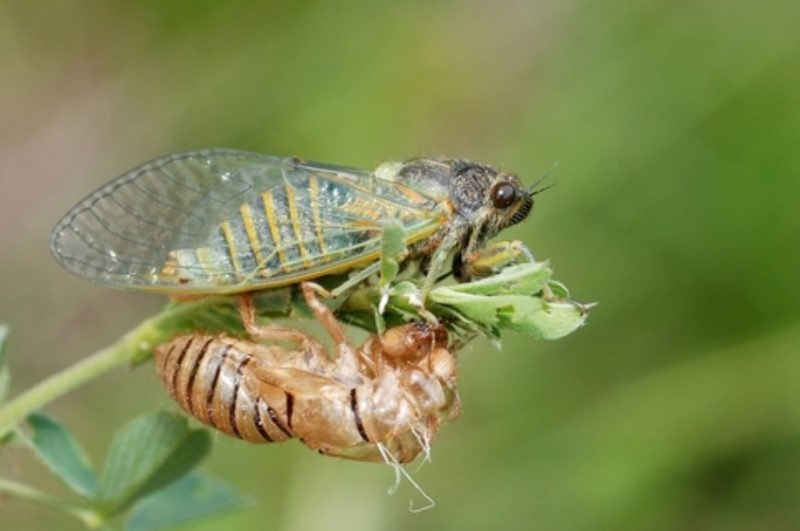
Magicicada tredecula is a 13-year periodical cicada species, part of the same genus as other Magicicada, but generally less commonly seen. It has a similar appearance to other members of its group, with black bodies, red eyes, and orange markings on the wings and thorax. Its emergence is coordinated with other 13-year species, though it tends to be less numerous.
This species typically measures about 25 to 29 millimeters in length. The wing veins are orange and semi-translucent, and the abdomen often appears darker compared to Magicicada tredecim. Although visually similar to its relatives, its size and subtle tone variations in body coloration help distinguish it in the field.
The male song of Magicicada tredecula is softer and less pulsating than that of tredecim. It’s characterized by a lower-pitched, buzzing note that ends with a slow fade, helping to identify the species during choruses. Males form small singing groups and use the song to attract females during their brief adult life.
In Texas, Magicicada tredecula emerges every 13 years, most often in late spring and early summer. It prefers wooded areas with mature deciduous trees. Their activity peaks during warm daytime hours, and like other periodical cicadas, they spend most of their lives underground before emerging synchronously.
Neotibicen pruinosus (Scissor Grinder)

Neotibicen pruinosus, commonly known as the Scissor Grinder cicada, is a large and robust annual cicada found throughout Texas. Unlike the periodical cicadas, it appears every year and is known for its green and black patterned body, dark eyes, and a whitish dusting (pruinose) on parts of the abdomen.
This species is typically around 30 to 35 millimeters (1.2 to 1.4 inches) long. It can be identified by its green coloration, prominent wing veins, and a faint “W”-shaped marking on the back. The pruinose white patches near the sides of the abdomen are especially helpful for recognition in the field.
The Scissor Grinder is named for its distinctive song, which sounds like the rhythmic grinding of scissors or a sharpening tool. The call is long, steady, and can last up to 20 seconds, often heard in the late afternoon or early evening. Males sing from high branches in trees to attract mates.
In Texas, Neotibicen pruinosus is active from late June through August. It is most common in urban areas, woodlands, and around tree-lined streets. These cicadas are strong fliers and are often spotted near hardwoods like oaks and elms. Their presence is marked by both their sound and shed nymphal exoskeletons.
Neotibicen winnemanna (Eastern Scissor(s) Grinder)

Neotibicen winnemanna, commonly referred to as the Eastern Scissor Grinder, is closely related to Neotibicen pruinosus and is sometimes confused with it. It features a similar green and black body with pruinose (powdery white) markings, but has subtle differences in call and distribution that set it apart.
This species is typically around 30 millimeters long and displays a green thorax with black markings and clear wings with greenish veins. The pruinose areas on the abdomen and behind the head are useful in distinguishing it. Compared to pruinosus, the wing coloration may be darker and more distinctly veined.
The male call is a continuous buzzing sound that rises and falls, resembling the Scissor Grinder song but with a slightly different pitch and rhythm. The sound often begins with a rising buzz, followed by a fluctuating pulse, then fades out. These variations help experts distinguish between closely related cicadas.
In Texas, Neotibicen winnemanna is found mostly in the eastern parts of the state during summer months. Its emergence starts around July and continues through August. It prefers forest edges, open woodlands, and even urban neighborhoods where large deciduous trees provide both habitat and calling perches.
Neotibicen tibicen (Swamp Cicada)
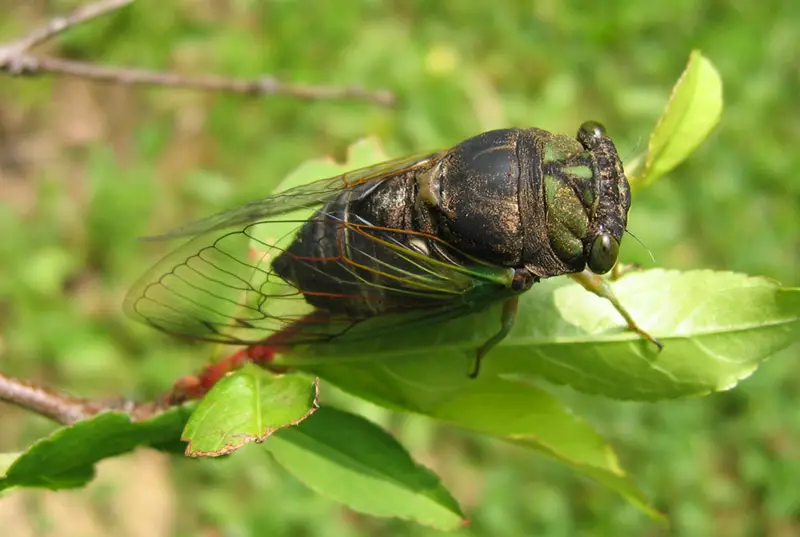
Neotibicen tibicen, often called the Swamp Cicada or Morning Cicada, is a medium-sized annual cicada known for its preference for moist, lowland habitats. It has a dark brown to black body with greenish wing veins and a noticeably pruinose (white-dusted) underside, especially near the legs and thorax.
This species measures around 28 to 32 millimeters in length. It is recognized by its relatively short wings compared to other Tibicen species and its pale ventral side. The pruinose coating gives it a dusty appearance, and it typically has a more muted green coloration on the thorax.
The call of Neotibicen tibicen is soft and musical, a rising and falling “whirring” buzz that is often heard in the early morning hours—earning it the nickname Morning Cicada. Unlike the intense calls of some relatives, its song is gentler and frequently overlaps with birdsong during dawn.
In Texas, Swamp Cicadas appear annually in summer, usually from June through August. They are most often found in riparian areas, swamps, and floodplain forests. Their calling activity starts earlier in the day than most other cicadas, with peak activity in the morning and just after sunrise.
Neotibicen dorsatus (Bush Cicada)
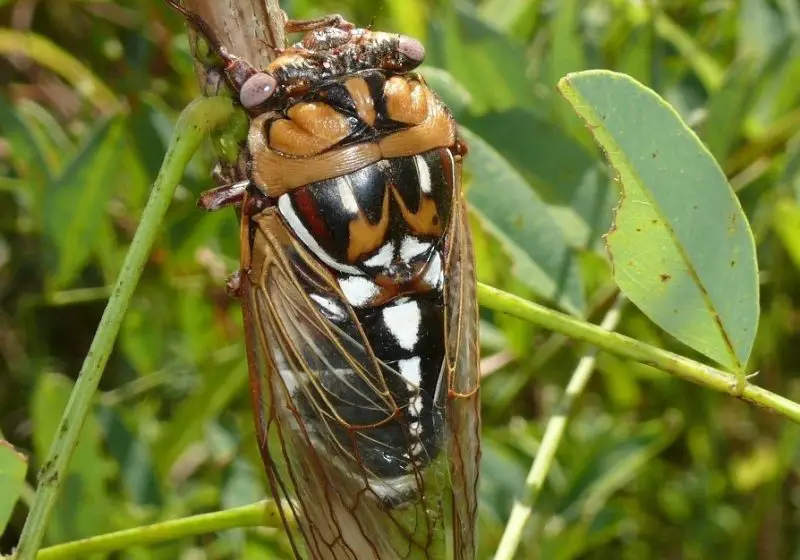
Neotibicen dorsatus, also known as the Bush Cicada or Giant Grassland Cicada, is a large and striking species with bold coloration. It features a black body with yellow or orange striping and clear wings with orange-brown veins. This species is a hallmark of prairie and grassland habitats in parts of Texas.
Adults are among the largest North American cicadas, reaching lengths of 35 to 40 millimeters (1.4 to 1.6 inches). The dorsal side shows a prominent central stripe with lateral markings, giving it a tiger-striped appearance. Its size and coloration make it one of the most easily recognized cicadas in the region.
The Bush Cicada’s song is a loud, pulsating buzz that rises and falls in volume, often described as aggressive or metallic in tone. The call is emitted by males perched on shrubs, fenceposts, or tall grasses. Unlike forest-dwelling cicadas, this species prefers open landscapes and calls from exposed locations.
In Texas, Neotibicen dorsatus emerges during the hot summer months, typically in July and August. It inhabits dry grasslands, prairies, and roadside fields where trees are sparse. The species is diurnal, with peak calling activity during the hottest parts of the day, often under full sun.
Neotibicen linnei (Linne’s Cicada)

Neotibicen linnei, commonly known as Linne’s Cicada, is an annual cicada species frequently found in Texas woodlands. It features a dark brown or black body with subtle green highlights on the thorax and clear wings with greenish veins. Its relatively plain appearance compared to other cicadas can make it harder to spot, but its call gives it away.
Adults measure approximately 27 to 33 millimeters in length. One of the distinguishing features is the smooth, uninterrupted green pronotal collar on the thorax. The abdomen is dark with little to no striping, and the legs and underside are usually lighter in color, aiding in its identification.
The male call of Linne’s Cicada is a short, repeated buzz that sounds like a rapid, pulsing whine. The sound is sometimes described as a “machine-like” buzz that tapers off at the end. It often overlaps with other cicadas, but its distinct pitch and pattern help differentiate it in a chorus.
In Texas, Linne’s Cicadas are commonly heard from July through September. They favor deciduous forests, parks, and residential neighborhoods with large trees. These cicadas usually call from the mid-canopy level, and their activity tends to peak in the afternoon heat.
Megatibicen auletes (Southern Giant Cicada)
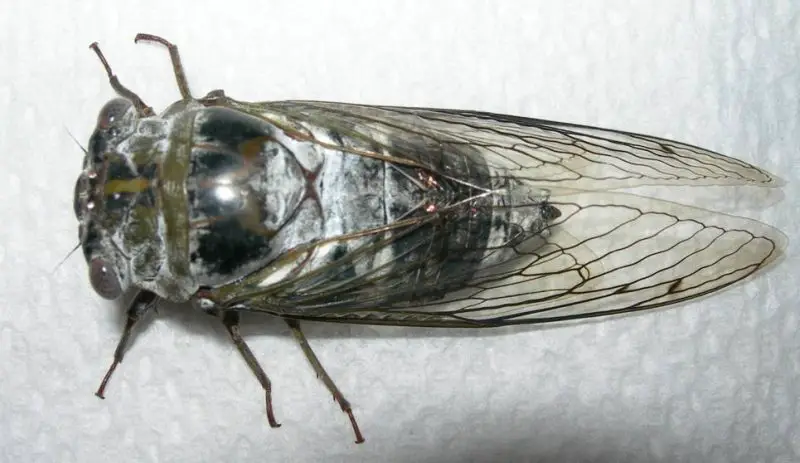
Megatibicen auletes, known as the Southern Giant Cicada, is one of the largest cicada species in North America. Found in the eastern parts of Texas, it has a robust body with dark brown and black coloration, accented by green markings and clear wings with strong orange veins.
Adults can grow up to 50 millimeters (2 inches) long, making them quite impressive in size. The head is broad, and the thorax is marked with symmetrical dark patterns. The eyes are brownish, and the pruinose (dusty) patches are usually visible on the sides of the abdomen.
The song of the Southern Giant Cicada is extremely loud and powerful, often described as a deep, roaring buzz that rises and falls. The call can be heard from long distances, especially in the evening. It’s one of the most thunderous cicada songs in the southern United States.
In Texas, Megatibicen auletes emerges annually from late June through August. It prefers large, mature hardwoods, especially oak trees, and is usually active from late afternoon into dusk. This cicada tends to call from high perches in the canopy and is most commonly found in rural or semi-wooded areas.
Megatibicen dealbatus (Plains Cicada)
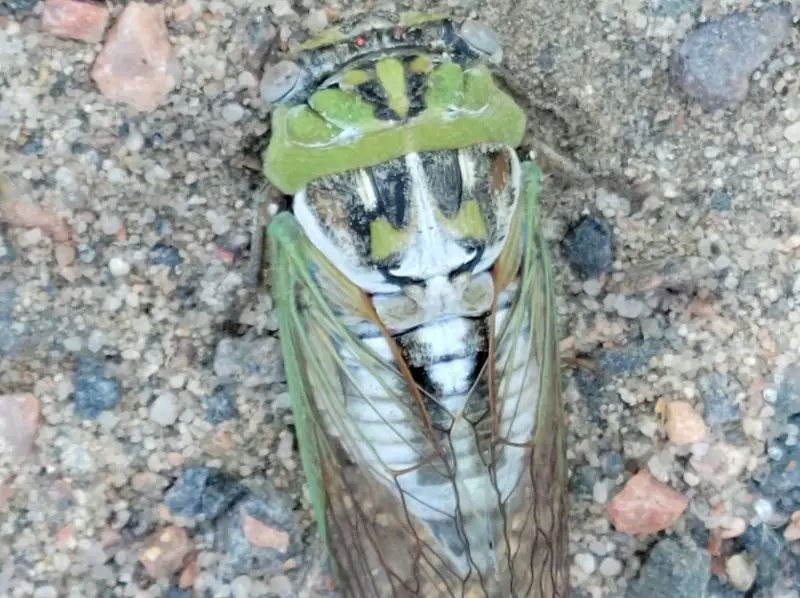
Megatibicen dealbatus, or the Plains Cicada, is a striking species found in open habitats across central and northern Texas. It has a pale greenish-brown body with prominent black markings and distinct pruinose patches on the sides. Its coloration blends well with the grasses and light soil of prairie regions.
This cicada is medium to large in size, typically ranging from 35 to 45 millimeters in length. It can be recognized by the whitish dusty appearance on its sides, a wide head, and broad wings with yellowish veins. The dorsal patterns are bold and often symmetrical, aiding in quick identification.
The call of the Plains Cicada is a long, rattling buzz that can sound like a series of rapid clicks or a harsh, metallic drone. Males sing from low shrubs or tall grasses, and their calls are most active during the hottest parts of the day under direct sunlight.
In Texas, Megatibicen dealbatus emerges in midsummer, generally from July through early September. It inhabits prairies, open fields, and lightly wooded areas, especially where mesquite or other shrubs are present. It is more often found in drier parts of the state and is rarely seen in dense forests.
Diceroprocta apache (Apache Cicada)
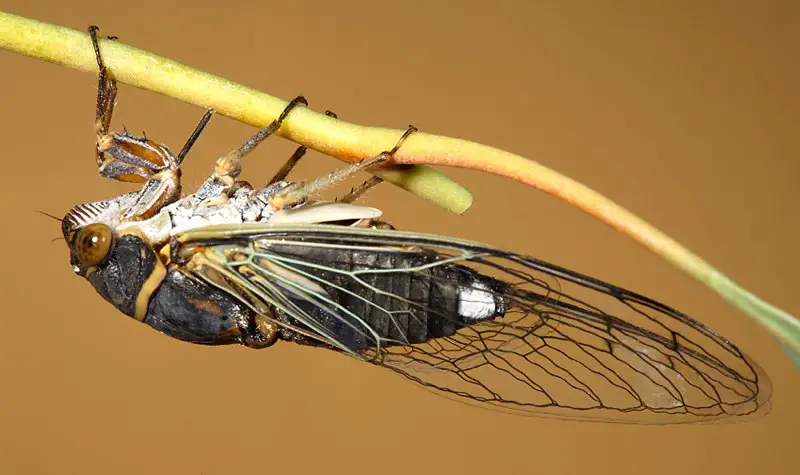
Diceroprocta apache, commonly known as the Apache Cicada, is one of the more widespread annual cicadas in Texas. It has a sleek, mostly black body with orange or yellowish wing veins and bright red eyes. Its size and coloration give it a glossy, eye-catching appearance during the summer months.
Adults are relatively small compared to some other species, typically measuring 22 to 28 millimeters long. Their transparent wings with golden-orange veins and black thorax with pale stripes make them easy to identify. The abdomen is typically dark with less visible pruinose.
The male Apache Cicada produces a piercing, high-pitched buzzing call that often resembles the whine of an electric motor. It is a continuous, strong sound that can last several seconds and is commonly heard during the heat of midday in desert or arid scrub regions.
In Texas, Diceroprocta apache appears from May through August and prefers drier, more open environments such as deserts, scrublands, and urban areas with sparse vegetation. These cicadas are often heard before they are seen and tend to call from mesquite, creosote, or other small desert trees.
Diceroprocta texana (Texas Cicada)
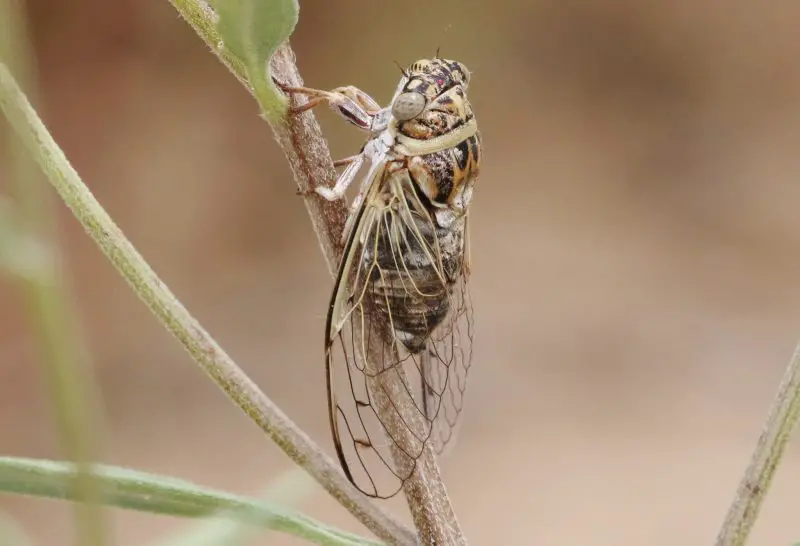
Diceroprocta texana, or the Texas Cicada, is a native species found mainly in central and southern Texas. It has a dark, sometimes reddish-brown body with clear wings and golden-orange veins. Like other Diceroprocta, it has a streamlined shape and is adapted to hot, arid environments.
Adults are medium-sized, measuring around 25 to 30 millimeters long. The body has lighter markings on the thorax, and the eyes are dark. It can be distinguished from Diceroprocta apache by its slightly larger size and more muted color contrast on the abdomen and thorax.
The song of the Texas Cicada is a fast, staccato buzz that resembles a crackling electric noise. It often pulses in short bursts and can vary in pitch. Males call from tree trunks or lower branches during hot days, particularly around midday when temperatures peak.
In Texas, Diceroprocta texana is most active from June through August. It is often found in mesquite groves, thorn scrub, and dry woodland edges. These cicadas thrive in sandy soils and dry climates and are a familiar summer sound in many parts of the state.
Okanagana arboraria
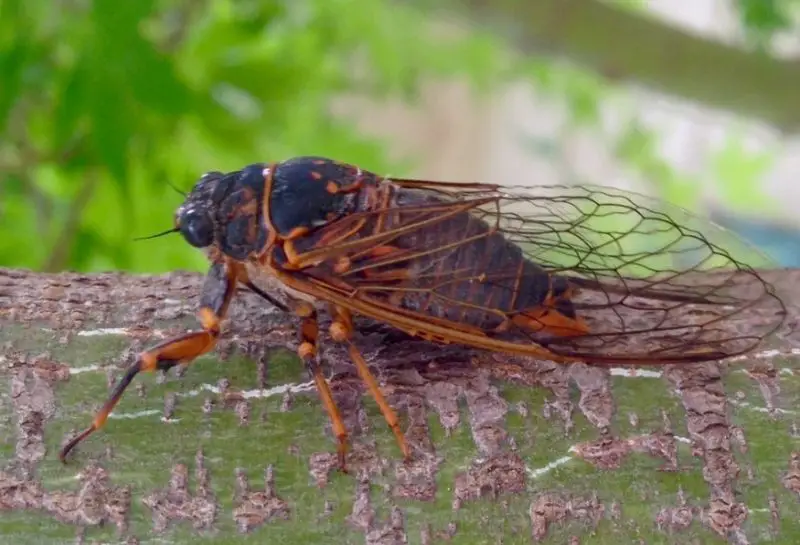
Okanagana arboraria is a lesser-known cicada species found in limited areas of western and central Texas. It is part of the genus Okanagana, which is more commonly associated with the western U.S. This species is typically small and has a black body with orange or rust-colored markings on the thorax and abdomen.
Adults are compact, usually about 20 to 25 millimeters long. Their wings are narrow and clear with light-colored veins. The orange striping along the sides and on the back provides a useful field mark. Compared to Neotibicen or Megatibicen species, they appear more slender and delicate.
The male call is a sharp, ticking buzz repeated in bursts, quieter and less sustained than other cicadas. It has a chirping quality and is usually heard in short phrases, particularly in the early morning or late afternoon. The call is localized and does not form large choruses.
In Texas, Okanagana arboraria emerges in late spring and early summer, typically May through June. It favors higher elevation habitats and oak-juniper woodlands. Due to its quiet call and limited distribution, it is often overlooked but can be found with attentive listening in the right habitat.






